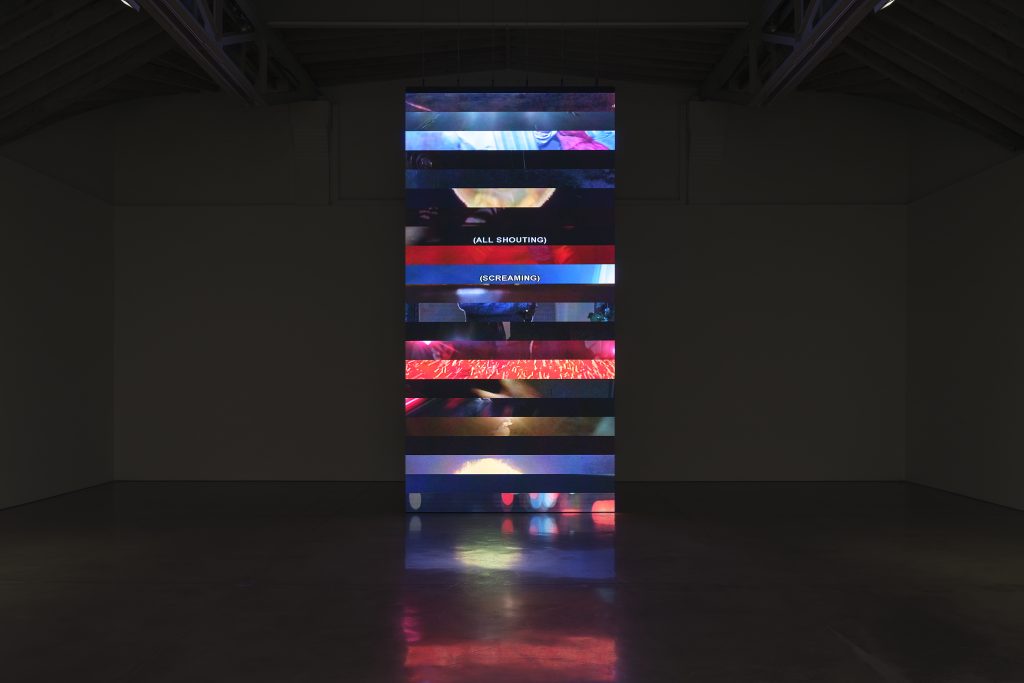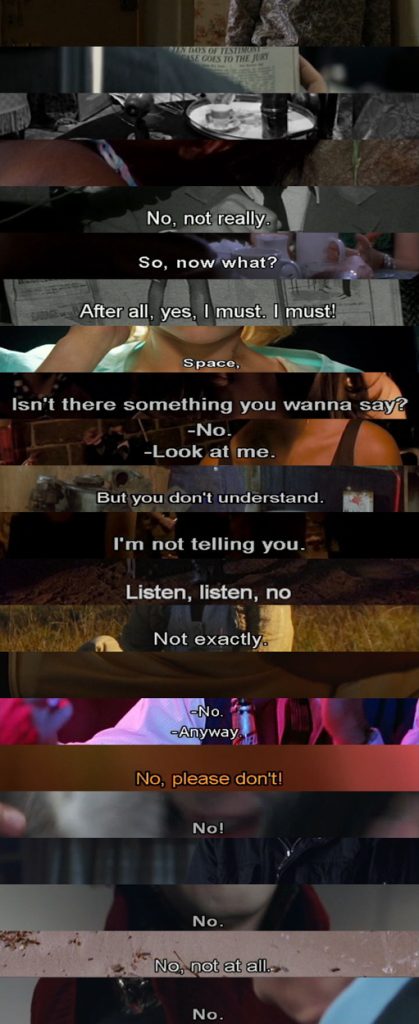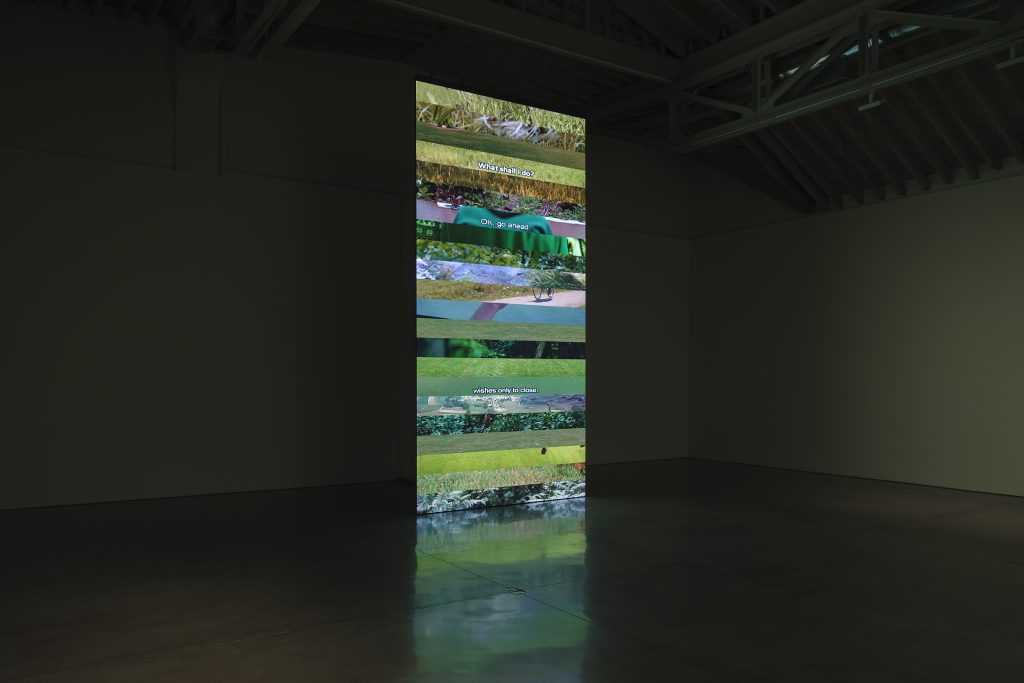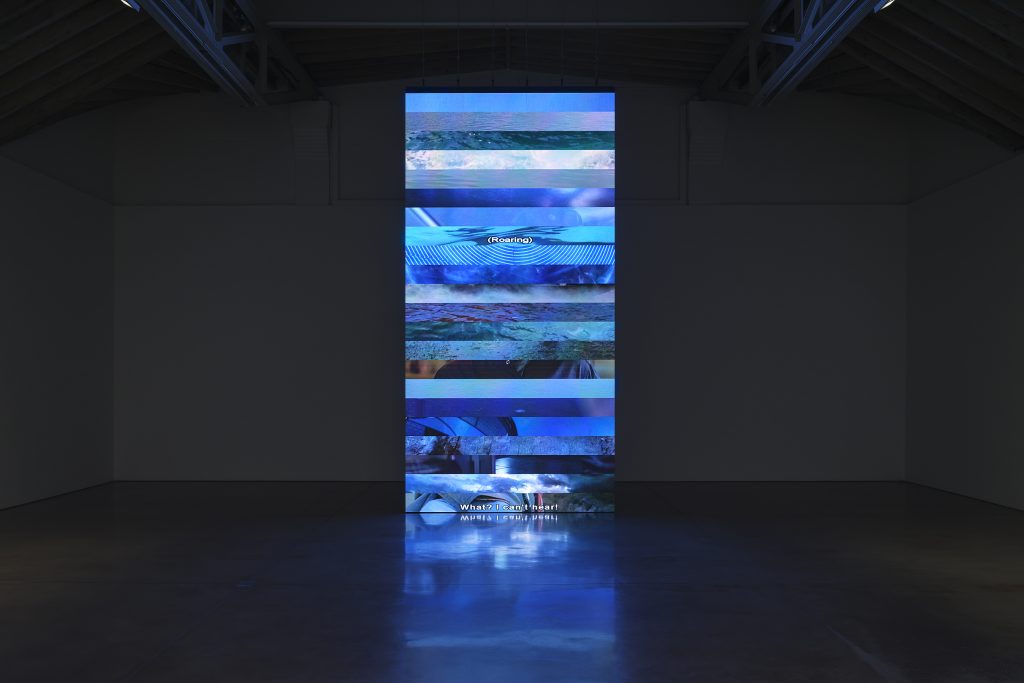The sense of recognition combined with a near lack of it; a eureka moment slipping away like the unstoppable but rotating tides of an ocean.
Such defined the fascinating piece “Subtitled” (2019) from Christian Marclay, the centerpiece of a new exhibition at Paula Cooper Gallery in New York City this September and October. The artwork was already exhibited elsewhere, but only outside of the United States, showing up in the country here for the first time.
“Subtitled”: A Towering Artistic Feat
The piece is nearly 20 feet tall. A video installation, the looming, flat, and silent screen presented to the viewer is subdivided into 22 different sections, each playing a bright, spiraling cavalcade of slivers of filmic works with the subtitles turned on, which sometimes deliver bits of speech and sometimes just transcribed indications of dramatic sound. And I mean slivers in a literal sense. Each portion shows just thin, visual strips from the source material.
I stood there to watch the visual avalanche for a while, and occasionally, I did recognize where something originated… but mostly, that kind of recognition was elusive. More centrally, I noticed the abbreviated visuals progressing into wide-ranging through-lines of color, theme, and content… moments of unity that quickly fell away, though later replaced by another.
The towering monument to visual achievement felt both accurate and captivating in its exploration of the relationship to — and creation of — visuals shared by major segments of contemporary culture. We rely on visuals with often the assumption of realism, even when confronted by alteration: editing, whether subtle or not. But “Subtitled” brought forward some inner workings of a visual, external experience of an environment coming together, challenging those assumptions.

Social Media & Our Internal Psychologies
Thinking back on the piece now, it mirrors the often discussed inclination to endlessly — well, nearly endlessly — scroll on social media.
Fueled these days by an explosion of short-form video content across the most popular social media apps, it’s a relentless push for the next moment of recognition — going, perhaps, both ways. We want to find something on which to latch, by definition only briefly, and in that, there has always been the push to be recognized and engaged with, whether we individually create a piece of content or find one linking to our experiences.
Algorithms notoriously appear to create echo chambers of sorts, showing us something in line with or closely connected to our previously expressed interests… again and again.
Ultimately, it’s snippets of content — whether literal social media content or some other bit of life — congealing into a whole, both naturally as our internal memories merge into each other and more artificially as the aesthetic screams of social media or a streaming service merge. I think that gaps behind our pushes towards aesthetic and experiential precision are there already. There’s an imperfection — a chaos.
And the flowing waves of brief portions of heavily cropped video in Marclay’s “Subtitled” connected to that experience, creating a space for seeking recognition as the towers of visuals built themselves up and fell apart, again and again. You’re left without clear, concise answers, no matter the trappings of familiarity that promise some eventual clarity. But the artwork keeps pushing.

Optimism and Light amid Unrest
While the indefinite striving embedded in many discussed experiences of social media can be damaging, “Subtitled” leans more into creating visual unity where there shouldn’t be any such thing, considering the wide-ranging divergence of this work’s many segments of video. The nods towards visual overwhelm were certainly there, but the moments where color across the wildly ranging segments was suddenly pretty similar kept things moving.
“Subtitled” was using the tidal waves of video, visuals, and text that define many modern-day experiences but breaking beyond them, talking instead about a moderated way in which each of us individually might successfully construct experiences of the world.
On an existential level — the level that movies tend to capture, where we try making sense of our place in a system far beyond ourselves individually — Marclay’s snippets of video fall apart but refuse to stay that way, from the continuous progression of each section of the screen through source video after source video to the more impactful, successful striving suggested by a work this utterly huge.
While the aesthetics were artistically chaotic at times, you couldn’t help, really, but be enthralled by the unity of it all. Marclay left individualized precision behind but created a magnificent waterfall of visuals that offered a new kind of clarity, one in which wildly different threads of text and images unite, somehow.
As visually precise as each clip of film was considering the nature of the camera work most often used in that kind of context, the certainty of an entire, fleshed out scene was absent. But there was something new, something that seemed subtly optimistic.
It was a vision where we do find clarity and the kind of experiential cohesion to strengthen a sense of self across tumbling panoplies of experience. As captured here, we’re enveloped in visuals, but remain an individual.
“Christian Marclay: Subtitled” remains on view through October 19.

Featured image: Installation view, Christian Marclay: Subtitled, Paula Cooper Gallery, New York, September 12 – October 19, 2024. Courtesy Paula Cooper Gallery, New York. Photo: Steven Probert
You may also like
-
Diana Kurz at Lincoln Glenn in New York: A Review of a Shining Art Exhibition
-
Dustin Hodges at 15 Orient in New York City: An Ensnaring Exhibition at an Exciting Gallery
-
Maren Hassinger at Susan Inglett Gallery in New York: Reviewing an Uplifting Art Exhibition
-
Enzo Shalom at Bortolami in New York City: Reviewing an Entrancing Exhibition of Paintings
-
“Ben Werther: Townworld” at Amanita in New York City: Reviewing a Richly Memorable Art Exhibition
